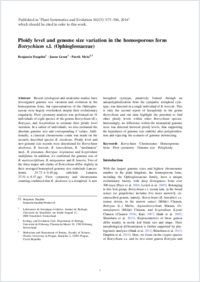Ploidy level and genome size variation in the homosporous ferns Botrychium
- Dauphin, Benjamin Laboratoire de botanique évolutive, Institut de Biologie, Université de Neuchâtel, Switzerland
- Grant, Jason Laboratoire de botanique évolutive, Institut de Biologie, Université de Neuchâtel, Switzerland
- Mráz, Patrik Ecology and Evolution Unit, Department of Biology, Université de Fribourg, Switzerland
-
07.03.2016
Published in:
- Plant Systematics and Evolution. - 2016, vol. 302, no. 5, p. 575–584
English
Recent cytological and molecular studies have investigated genome size variation and evolution in the homosporous ferns, but representatives of the Ophioglossaceae were largely overlooked, despite their evolutionary singularity. Flow cytometry analysis was performed on 41 individuals of eight species of the genera Botrychium (B.), Botrypus, and Sceptridium to estimate their ploidy level variation. In a subset of individuals, we also estimated the absolute genome size and corresponding C values. Additionally, a classical chromosome count was made on the recently described species B. alaskense. Ploidy level and new genome size records were determined for Botrychium alaskense, B. boreale, B. lanceolatum, B. “neolunaria” ined., B. pinnatum, Botrypus virginianus and Sceptridium multifidum. In addition, we confirmed the genome size of B. matricariifolium, B. minganense and B. lunaria. Two of the three major sub-clades of Botrychium differ slightly in their averaged homoploid genome size (subclade Lanceolatum, 24.72 ± 0.40 pg; subclade Lunaria, 27.51 ± 0.47 pg). Flow cytometry and chromosome counting confirmed that B. alaskense is a tetraploid. A new hexaploid cytotype, putatively formed through an autopolyploidization from the sympatric tetraploid cytotype, was detected in a single individual of B. boreale. This is only the second report of hexaploidy in the genus Botrychium and our data highlight the potential to find other ploidy levels within other Botrychium species. Interestingly, no difference within the monoploid genome sizes was detected between ploidy levels, thus supporting the hypothesis of genome size stability after polyploidization and rejecting the scenario of genome downsizing.
- Faculty
- Faculté des sciences et de médecine
- Department
- Département de Biologie
- Language
-
- English
- Classification
- Biological sciences
- License
- License undefined
- Identifiers
-
- RERO DOC 261059
- DOI 10.1007/s00606-016-1285-7
- Persistent URL
- https://folia.unifr.ch/unifr/documents/304961
Statistics
Document views: 73
File downloads:
- mra_plg.pdf: 149
